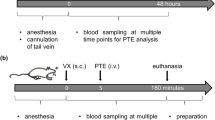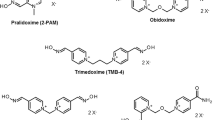Abstract
Pyridostigmine (PSTG) is a carbamate inhibitor of cholinesterases. Carbamates are known to confer some protection from the lethal effects of (some) organophosphorus compounds. Recently, based on animal data, the FDA approved oral PSTG for pre-exposure treatment of soman. The purpose of the study was to quantify in vivo the effect of PSTG pre-treatment on survival in rats exposed to the organophosphate paraoxon (POX) with and without subsequent reactivator (pralidoxime) treatment. POX is a highly toxic non-neuropathic ethyl organophospate. Pralidoxime (PRX) is the enzyme reactivator used by some NATO armies. The prospective, controlled animal (rat) study included Group 1 that received 1 μmol POX (≈LD75); Group 2 that received 1 μmol PSTG followed 30 min later by 1 μmol POX; Group 3 that received 1 μmol PSTG followed 30 min later by 1 μmol POX and 50 μmol PRX; Group 4 that received 1 μmol POX and 50 μmol PRX; Group 5 that received 1 μmol PSTG; Group 6 that received 50 μmol PRX and Group 7 that received 1 μmol PSTG followed 30 min later by 50 μmol PRX. Each group contained six rats. The experiment was repeated twelve times (12 cycles). All substances were applied i.p. From surviving animals of eight cycles tail blood was taken for red blood cell acetylcholinesterase (RBC-AChE) measurements. The animals were monitored for 48 h and mortality (survival time) was recorded. RBC-AChE activities were determined. Mortality was analysed using Kaplan–Meier plots. Both PSTG and PRX statistically significantly decreased organophosphate induced mortality in the described model. While the same applies to their combination the decrease in mortality when using both PSTG and PRX is less than that achieved with their single use (but not significantly so). While certainly further work using different organophosphorus compounds and animal species are needed before a final conclusion is reached, the animal data presented does not support the combined use of PSTG and PRX.

Similar content being viewed by others
References
Anderson DR, Harris LW, Woodard CL, Lennox WJ (1992) The effect of pyridostigmine pre-treatment on oxime efficacy against intoxication by soman or VX in rats. Drug Chem Toxicol 15:285–294
Bajgar J (2004) Organophosphates/nerve agent poisoning: mechanism of action, diagnosis, prophylaxis, and treatment. Adv Clin Chem 38:151–216
Benschof HP, Konings KAS, Kossen SP, Ligtenstein DA (1981) Determination of some pyridinium aldoxime compounds by means of ion-pair reversed-phase high-performance liquid chromatography: application in biological material. J Chromatogr 225:107–114
Berry WK, Davies DR (1970) The use of carbamates and atropine in the protection of animals against poisoning by trimethylpropyl methylphosphonofluoridate. Biochem Pharmacol 19:927–934
Buckley N, Eddleston M, Szinicz L (2005) Oximes for acute organophosphate pesticide poisoning. Cochrane Database Syst Rev 1:CD005085
Dart RC, Goldfrank LR, Chyka PA, Lotzer D, Woolf AD, McNally J, Snodgrass WR, Olson KR, Scharman E, Geller RJ, Spyker D, Kraft M, Lipsy R (2000) Combined evidence-based literature analysis and consensus guidelines for stocking of emergency antidotes in the United States. Ann Emerg Med 36:126–132
Dunn MA, Hackley BE, Sidell FR (1997) Pretreatment for nerve agent exposure. In: Sidell FR, Takafuji ET, Franz DR (eds) Textbook of military medicine: medical aspects of chemical & biological warfare. Borden Institute, Walter Reed Army Medical Center, Washington, pp 181–196
Eddleston M, Szinicz L, Eyer P, Buckley N (2002) Oximes in acute organophosphorus pesticide poisoning: a systematic review of clinical trials. QJM 95:275–283
Ellman Gl, Courtney KD, Andres VJR, Feather-Stone RM (1961) A new and rapid colorimetric determination of acetyl-cholinesterase activity. Biochem Pharmacol 7:88–95
Gall D (1981) The use of therapeutic mixtures in the treatment of cholinesterase inhibition. Fundam Appl Toxicol 1(2):214–216
Johnson MK, Jacobsen D, Meredith TJ, Eyer P, Heath AJ, Ligtenstein DA, Marrs TC, Szinicz L, Vale JA, Haines JA (2000) Evaluation of antidotes for poisoning by organophosphourus pesticides. Emerg Med 12:22–37
van Kampen EJ, Zijlstra WG (1961) Standardization of hemoglobinometry II. The hemoglobincyanide method. Clin Chim Acta 6:538–544
Kaplan EL, Meier P (1958) Nonparametric estimation from incomplete observations. J Am Stat Assoc 53:457–481
Koelle GB (1946) Protection of cholinesterases against irreversible inactivation by DFP in vitro. J Pharmacol Exp Ther 88:323–327
Koplovitz I, Harris LW, Anderson DR, Lennox WJ, Stewart JR (1992) Reduction by pyridostigmine pretreatment of the efficacy of atropine and 2-PAM treatment of sarin and VX poisoning in rodents. Fundam Appl Toxicol 18:102–106
Koster R (1946) Synergisms and antagonisms between physostigmine and di-isopropyl fluorophosphates in cats. J Pharmacol Exp Ther 88:39–46
Layish I, Krivoy A, Rotman E, Finkelstein A, Tashma Z, Yehezkelli Y (2005) Pharmacologic prophylaxis against nerve agent poisoning. IMAJ 7:182–187
Levine R (1991) Recognized and possible effects of pesticides in humans. In: Hayes WJ, Laws ER (eds) Handbook of pesticide toxiclogy, general principles, vol 1. Academic, San Diego, pp 275–360
Namba T (1971) Cholinesterase inhibition by organophospourus compounds, and its clinical effects. Bull WHO 44:289–307
Namba T, Nolte CT, Jackrel J, Grob D (1971) Poisoning due to organophosphate insecticides: acute and chronic manifestations. Am J Med 50:475–492
Nostrandt AC, Duncan JA, Padilla S (1993) A modified spectrophotometric method appropriate for measuring cholinesterase activity in tissue from carbaryl-treated animals. Fundam Appl Toxicol 21:196–203
Peter JV, Cherian AM (2000) Organic insecticides. Anaesth. Intensive Care 28:11–21
Petroianu G (2005) Organophosphate poisoning: the lesser-known face of a toxidrome. Eur J Emerg Med 12:102–103
Petroianu G, Toomes LM, Petroianu A, Bergler W, Rufer R (1998) Control of blood pressure, heart rate and haematocrit during high-dose intravenous paraoxon exposure in mini pigs. J Appl Toxicol 18:293–298
Petroianu GA, Hasan MY, Nurulain SM, Arafat K, Sha Ullah M, Naseer O (2005a) Protective agents in acute high dose organophosphate exposure: comparison of ranitidine with pralidoxime in rats. J Appl Toxicol 25:68–73
Petroianu GA, Hasan MY, Nurulain SM, Arafat K, Sheen R, Saleh A, Schmitt A (2005b) Protective drugs in acute large-dose exposure to organophosphates: a comparison of metoclopramide and tiapride with pralidoxime in rats. Anesth Analg 100:382–386
Pyridostigmine Bromide Package Insert (2003) http://www.jrcab.army.mil/PBpkgInsert190203.pdf Last accessed on February 26st, 2006
Thiermann H, Szinicz L, Eyer P, Zilker T, Worek F (2005) Correlation between red blood cell acetylcholinesterase activity and neuromuscular transmission in organophosphate poisoning. Chem Biol Interact 157–158C:345–347
Traina ME, Serpieri LA (1984) Changes in the levels and forms of rat plasma cholinesterases during chronic diisopropylphosphorofluoridate intoxication. Biochem Pharmacol 33:645–653
Wiener SW, Hoffman RS (2004) Nerve agents: a comprehensive review. J Intensive Care Med 19:22–37
Wilson IB, Ginsburg SA (1955) Powerful reactivator of alkylphosphate-inhibited acetylcholinesterase. Biochim Biophys Acta 18:168–70
Worek F, Szinicz L (1995) Cardiorespiratory function in nerve agent poisoned and oxime + atropine treated guinea-pigs: effect of pyridostigmine pretreatment. Arch Toxicol 69:322–329
Worek F, Kleine A, Szinicz L (1995) Effect of pyridostigmine pretreatment on cardiorespiratory function in tabun poisoning. Hum Exp Toxicol Aug 14:634–642
Worek F, Mast U, Kiderlen D, Diepold C, Eyer P (1999) Improved determination of acetylcholinesterase activity in human whole blood. Clin Chim Acta 288:73–90
Zoch E (1971) Die Wirkung organischer Phosphorsäureester bzw. Phosphonsäureester auf versch. Enzyme Arzneim Forschung 21:181–187
Acknowledgments
This work was supported by individual university grant # 01-04-8-11/04 from the United Arab Emirates University (UAEU).
Author information
Authors and Affiliations
Corresponding author
Rights and permissions
About this article
Cite this article
Petroianu, G.A., Nurulain, S.M., Arafat, K. et al. Effect of pyridostigmine, pralidoxime and their combination on survival and cholinesterase activity in rats exposed to the organophosphate paraoxon . Arch Toxicol 80, 777–784 (2006). https://doi.org/10.1007/s00204-006-0098-9
Received:
Accepted:
Published:
Issue Date:
DOI: https://doi.org/10.1007/s00204-006-0098-9




